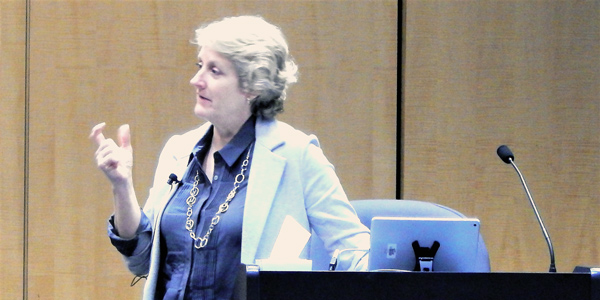By Tom Kleckner
AUSTIN, Texas — ERCOT stakeholders are once again raising the subject of real-time co-optimization (RTC) after a simulation of a recent market event showed that the ISO might have saved almost $60 million using the process.
Beth Garza, director of ERCOT’s Independent Market Monitor, shared her organization’s analysis of the scarcity event with the ISO’s Board of Directors on Tuesday. The grid operator would have saved $58.5 million over eight five-minute intervals had it been using RTC, she said.
RTC is the process of procuring energy and ancillary services simultaneously in the real-time market, with the intent of finding the most cost-effective solution for both requirements every five minutes.
“This was $58 million over 40 minutes, but every hour, there are hundreds of pennies and nickels and dollars that can be picked up,” Garza said.
On Jan. 23, real-time prices hit the energy offer cap of $9,000/MWh during two five-minute intervals. ERCOT blamed the spike on ramping issues because of cold weather and higher-than-expected load during early morning hours, but it also said resource adequacy was not a problem. (See “TAC Asks WMS to Investigate 2 Market Events,” ERCOT Technical Advisory Committee Briefs: Jan. 25, 2018.)
Using its own software and a simulation based on the security-constrained economic dispatch (SCED) 60-day report, the Monitor determined RTC would have capped prices at $7,500 during the event.
“Software is the heart of real-time co-optimization,” Garza said. “The magic was we got to move reserves. As we moved those reserves around, we moved away from fast-ramping units to slower-ramping units. By actively making decisions every five minutes, we were able to move reserves over to slightly less rampable capacity, freeing up lots of ramping capacity for five-minute energy.”
Garza made no secret of the Monitor’s advocacy for RTC, saying, “We had reserves. We had a shortage of energy. [With RTC], we could have made better choices about which units were carrying reserves and lowered energy prices.”
“This is an efficiency issue,” said Director Peter Cramton, a University of Maryland economics professor. “What you get with co-optimization is improved pricing and quantities of the resources … making the best use of existing resources in real time. That’s primary to our mission, and I think we should take it seriously.”
ERCOT staff pointed out that the Public Utility Commission of Texas has an open proceeding (Project No. 47199) investigating the use of RTC to address intermittent renewables and improve incentives for generators. The PUC has held two market reform workshops and gathered input on a wide range of potential improvements. (See ERCOT, Regulators Discuss Need for Pricing Rule Changes.)
PUC Chair DeAnn Walker made it clear that the commission is not ignoring the issue, pointing out that regulators requested a cost-benefit study in October.
“We’re doing this in a thoughtful way,” Walker said. “This is the cost, this is the benefit … we’re asking for true data. We’re asking for these studies to be done, in a thoughtful manner.”
ERCOT has already told the PUC it will cost about $40 million and as many as five years to implement RTC because of the project’s complexity and scope. Staff has said an RTC upgrade would touch as many as 13 ISO systems.
Year in Review
In reviewing 2017 market data with the board, Garza said load-weighted average real-time prices were up almost $4/MWh from 2016’s historic low, to $28.25/MWh. Those are the market’s highest prices since 2014, when the average was $40.64.
“We’re on the low end of prices,” she said, alluding to an average fuel index price of $2.98/MMBtu.
While energy prices have dropped since the ISO’s nodal market went live in 2010, spreads continue to exist among ERCOT’s various zones. Real-time energy prices in the Houston zone averaged around $32/MWh in 2017 but hovered around $25 in the west, with its plentiful and cheap wind energy.
ERCOT’s costliest constraint lies in the Panhandle, accumulating $140 million in congestion costs and preventing further West Texas wind from flowing into the system.
Garza said much of the congestion is related to construction, likening it to fixing the weakest link, and then the next weakest link. She used another analogy that Austinites in the audience know all too well when she compared congestion to highway construction.
“As lanes are added, congestion increases during construction,” Garza said. “It’s not uncommon for capacity to be reduced before you see a big expansion.”
The Panhandle constraint is being addressed by several projects completed or nearing completion: a synchronous condenser that went into service earlier in the week, another condenser due to go online in April and a 345-kV circuit addition expected to be energized by March 1.
At the same time, the $590 million Houston Import Project is scheduled to be completed later this spring to allow more power to be imported from the north. ERCOT staff are also closely watching the Lower Rio Grande Valley, where two dynamic reactive devices are expected to be in service later this year, addressing that region’s continued growth.
Garza said load-weighted costs for ancillary services have dropped from $1.23/MWh in 2015 to 87 cents/MWh last year, because “we’re buying the right amount of services at the right time.”




